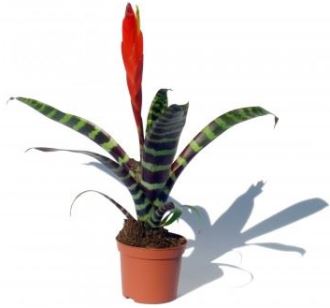





The flaming sword bromeliad is a flowering plant which belongs to the vriesea genus and bromeliaceae family. Like other bromeliads this species has a rosette of leaves and a cup or vase in the center which has to be filled with water regularly.
Many bromeliads can grow out of hand (that's fine outdoors and can be a pain indoors), but fortunately the splendens keeps its maximum growth size quite manageable ( height 2 ft - diameter 1½ ft) which is why its a popular house plant.
Caring for these is not difficulty, just different from other plants because they only require the center vase to be watered and not the soil. In fact, in their natural habitat they do not need soil and will grow on trees. The roots are very small on this plant compared to most house plants and do not take water and nutrients from the root system.
Most bromeliads are grown mainly for flowering and others for the attractive foliage. This plant is so attractive it's grown for both.
How it looks: The wide arching leaves have teh most striking zebra appearance aboit them and grow up to 1½ ft in length. The long flower head that rises well above the foliage has bright red bracts, shaped kind of like a sword and flat. Other vriesea plants grow with various types of foliage, flower head colors and shapes.
Flowering: Vriesea splendens are in no rush to bloom flowers for you and need patience. This obviously depends on the age of the plant when a grower receives it. Grown from a pup it can take a few years or possibly less in ideal conditions. I find the bract is the most attractive part of the flowering process rather than the small tubular greenish yellow flowers that appear.
Once the flowers have bloomed (which can last for a few months) and begin to die the plant will also die. The middle section of the plant will produce offsets that can be re-potted or placed on a bromeliad tree. These plants are potted for a place to sit rather than the soil, which is why they can be planted on a bromeliad tree (a large tree branch that can be used indoors).

The flaming sword is a great ornamental decorative plant which is fairly easy to grow. The main requirements is the correct amount of light and NOT to over-water.
Brown leaf tips: I would say dry air is the first possible cause, which misting will improve . Or there could be a chance the plants vase has not been filled with water.
Brown leaf patches: The most likely cause is too much direct sun. Place the plant where there is less direct sun.
Plant dies: After flowering as mentioned above it is time for this plant to die it's natural death. If it has not bloomed as yet, then the possible cause could be over- watering.
Insects: Mealy bug and scale can be a problem.
Copyright © www.100flowers.win Botanic Garden All Rights Reserved